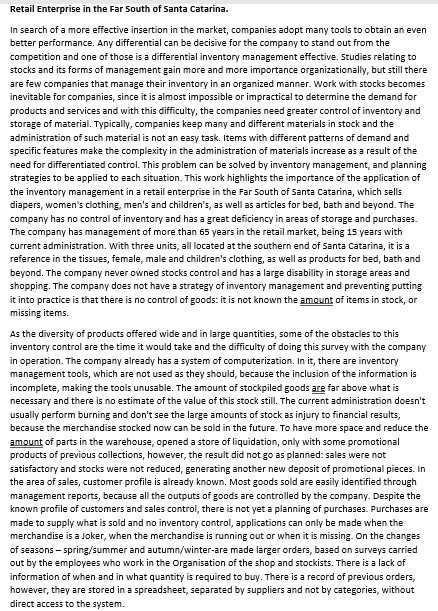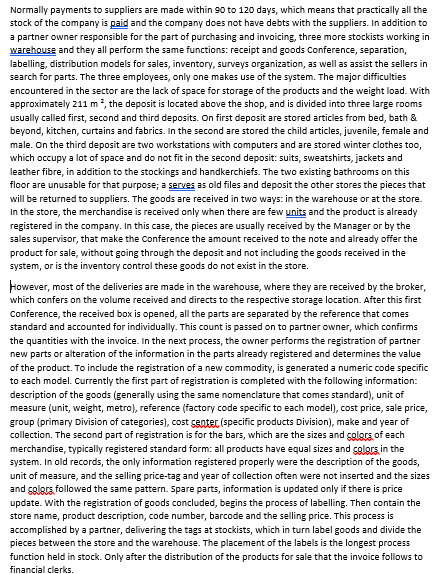Evaluate the main challenges faced by a retail enterprise in the Far South of Santa Catarina.
Evaluate the main challenges faced by a retail enterprise in the Far South of Santa Catarina.
Purchasing and Supply Chain Management
6th Edition
ISBN:9781285869681
Author:Robert M. Monczka, Robert B. Handfield, Larry C. Giunipero, James L. Patterson
Publisher:Robert M. Monczka, Robert B. Handfield, Larry C. Giunipero, James L. Patterson
Chapter16: Lean Supply Chain Management
Section: Chapter Questions
Problem 10DQ: The chapter presented various approaches for the control of inventory investment. Discuss three...
Related questions
Question
100%
Evaluate the main challenges faced by a retail enterprise in the Far South of Santa Catarina. (Using the attached)

Transcribed Image Text:Retail Enterprise in the Far South of Santa Catarina.
In search of a more effective insertion in the market, companies adopt many tools to obtain an even
better performance. Any differential can be decisive for the company to stand out from the
competition and one of those is a differential inventory management effective. Studies relating to
stocks and its forms of management gain more and more importance organizationally, but still there
are few companies that manage their inventory in an organized manner. Work with stocks becomes
inevitable for companies, since it is almost impossible or impractical to determine the demand for
products and services and with this difficulty, the companies need greater control of inventory and
storage of material. Typically, companies keep many and different materials in stock and the
administration of such material is not an easy task. Items with different patterns of demand and
specific features make the complexity in the administration of materials increase as a result of the
need for differentiated control. This problem can be solved by inventory management, and planning
strategies to be applied to each situation. This work highlights the importance of the application of
the inventory management in a retail enterprise in the Far South of Santa Catarina, which sells
diapers, women's clothing, men's and children's, as well as articles for bed, bath and beyond. The
company has no control of inventory and has a great deficiency in areas of storage and purchases.
The company has management of more than 65 years in the retail market, being 15 years with
current administration. With three units, all located at the southern end of Santa Catarina, it is a
reference in the tissues, female, male and children's clothing, as well as products for bed, bath and
beyond. The company never owned stocks control and has a large disability in storage areas and
shopping. The company does not have a strategy of inventory management and preventing putting
it into practice is that there is no control of goods: it is not known the amount of items in stock, or
missing items.
As the diversity of products offered wide and in large quantities, some of the obstacles to this
inventory control are the time it would take and the difficulty of doing this survey with the company
in operation. The company already has a system of computerization. In it, there are inventory
management tools, which are not used as they should, because the inclusion of the information is
incomplete, making the tools unusable. The amount of stockpiled goods are far above what is
necessary and there is no estimate of the value of this stock still. The current administration doesn't
usually perform burning and don't see the large amounts of stock as injury to financial results,
because the merchandise stocked now can be sold in the future. To have more space and reduce the
amount of parts in the warehouse, opened a store of liquidation, only with some promotional
products of previous collections, however, the result did not go as planned: sales were not
satisfactory and stocks were not reduced, generating another new deposit of promotional pieces. In
the area of sales, customer profile is already known. Most goods sold are easily identified through
management reports, because all the outputs of goods are controlled by the company. Despite the
known profile of customers and sales control, there is not yet a planning of purchases. Purchases are
made to supply what is sold and no inventory control, applications can only be made when the
merchandise is a Joker, when the merchandise is running out or when it is missing. On the changes
of seasons - spring/summer and autumn/winter-are made larger orders, based on surveys carried
out by the employees who work in the Organisation of the shop and stockists. There is a lack of
information of when and in what quantity is required to buy. There is a record of previous orders,
however, they are stored in a spreadsheet, separated by suppliers and not by categories, without
direct access to the system.

Transcribed Image Text:Normally payments to suppliers are made within 90 to 120 days, which means that practically all the
stock of the company is paid and the company does not have debts with the suppliers. In addition to
a partner owner responsible for the part of purchasing and invoicing, three more stockists working in
warehouse and they all perform the same functions: receipt and goods Conference, separation,
labelling, distribution models for sales, inventory, surveys organization, as well as assist the sellers in
search for parts. The three employees, only one makes use of the system. The major difficulties
encountered in the sector are the lack of space for storage of the products and the weight load. With
approximately 211 m², the deposit is located above the shop, and is divided into three large rooms
usually called first, second and third deposits. On first deposit are stored articles from bed, bath &
beyond, kitchen, curtains and fabrics. In the second are stored the child articles, juvenile, female and
male. On the third deposit are two workstations with computers and are stored winter clothes too,
which occupy a lot of space and do not fit in the second deposit: suits, sweatshirts, jackets and
leather fibre, in addition to the stockings and handkerchiefs. The two existing bathrooms on this
floor are unusable for that purpose; a serves as old files and deposit the other stores the pieces that
will be returned to suppliers. The goods are received in two ways: in the warehouse or at the store.
In the store, the merchandise is received only when there are few units and the product is already
registered in the company. In this case, the pieces are usually received by the Manager or by the
sales supervisor, that make the Conference the amount received to the note and already offer the
product for sale, without going through the deposit and not including the goods received in the
system, or is the inventory control these goods do not exist in the store.
However, most of the deliveries are made in the warehouse, where they are received by the broker,
which confers on the volume received and directs to the respective storage location. After this first
Conference, the received box is opened, all the parts are separated by the reference that comes
standard and accounted for individually. This count is passed on to partner owner, which confirms
the quantities with the invoice. In the next process, the owner performs the registration of partner
new parts or alteration of the information in the parts already registered and determines the value
of the product. To include the registration of a new commodity, is generated a numeric code specific
to each model. Currently the first part of registration is completed with the following information:
description of the goods (generally using the same nomenclature that comes standard), unit of
measure (unit, weight, metro), reference (factory code specific to each model), cost price, sale price,
group (primary Division of categories), cost center (specific products Division), make and year of
collection. The second part of registration is for the bars, which are the sizes and colors of each
merchandise, typically registered standard form: all products have equal sizes and colors in the
system. In old records, the only information registered properly were the description of the goods,
unit of measure, and the selling price-tag and year of collection often were not inserted and the sizes
and colors followed the same pattern. Spare parts, information is updated only if there is price
update. With the registration of goods concluded, begins the process of labelling. Then contain the
store name, product description, code number, barcode and the selling price. This process is
accomplished by a partner, delivering the tags at stockists, which in turn label goods and divide the
pieces between the store and the warehouse. The placement of the labels is the longest process
function held in stock. Only after the distribution of the products for sale that the invoice follows to
financial clerks.
Expert Solution
This question has been solved!
Explore an expertly crafted, step-by-step solution for a thorough understanding of key concepts.
Step by step
Solved in 3 steps

Recommended textbooks for you

Purchasing and Supply Chain Management
Operations Management
ISBN:
9781285869681
Author:
Robert M. Monczka, Robert B. Handfield, Larry C. Giunipero, James L. Patterson
Publisher:
Cengage Learning

Purchasing and Supply Chain Management
Operations Management
ISBN:
9781285869681
Author:
Robert M. Monczka, Robert B. Handfield, Larry C. Giunipero, James L. Patterson
Publisher:
Cengage Learning